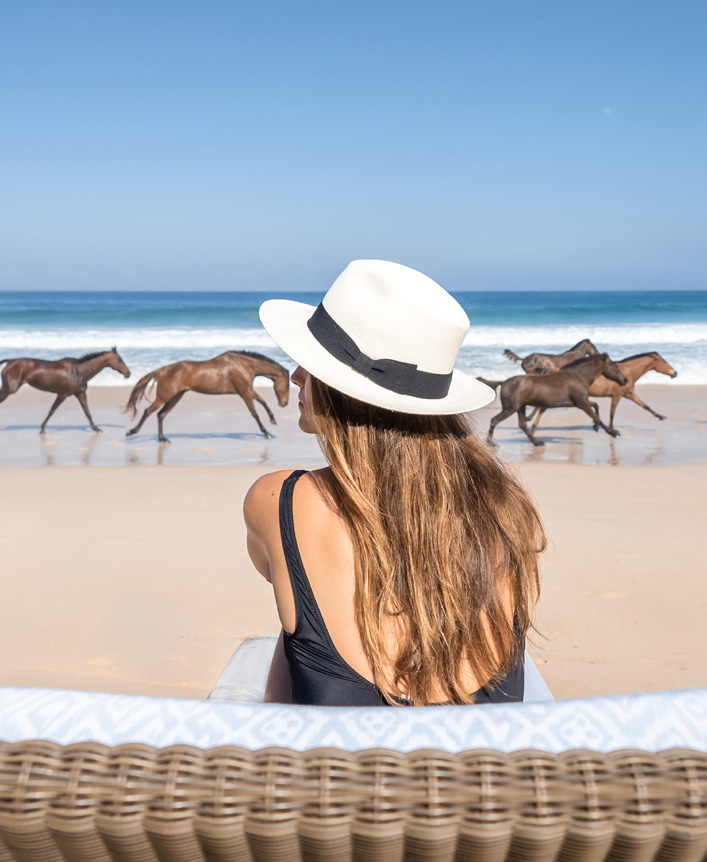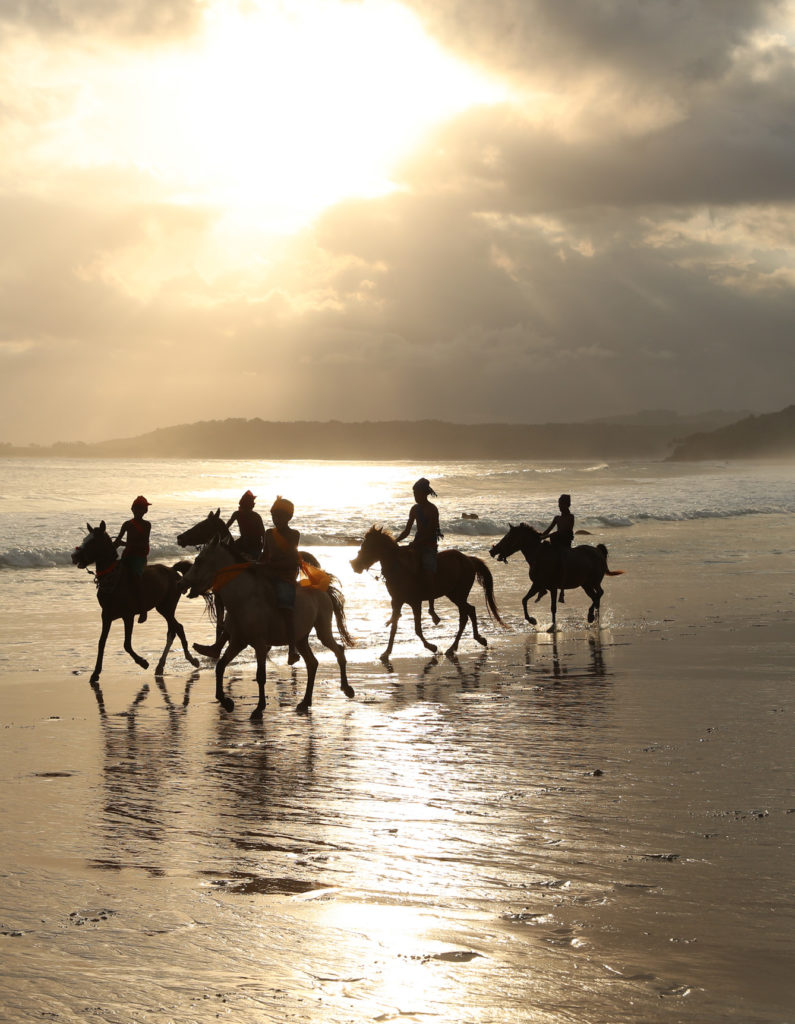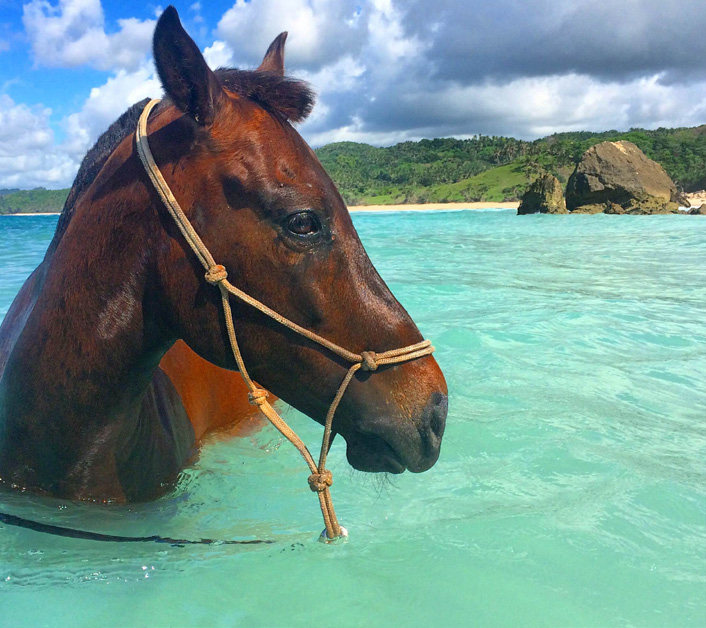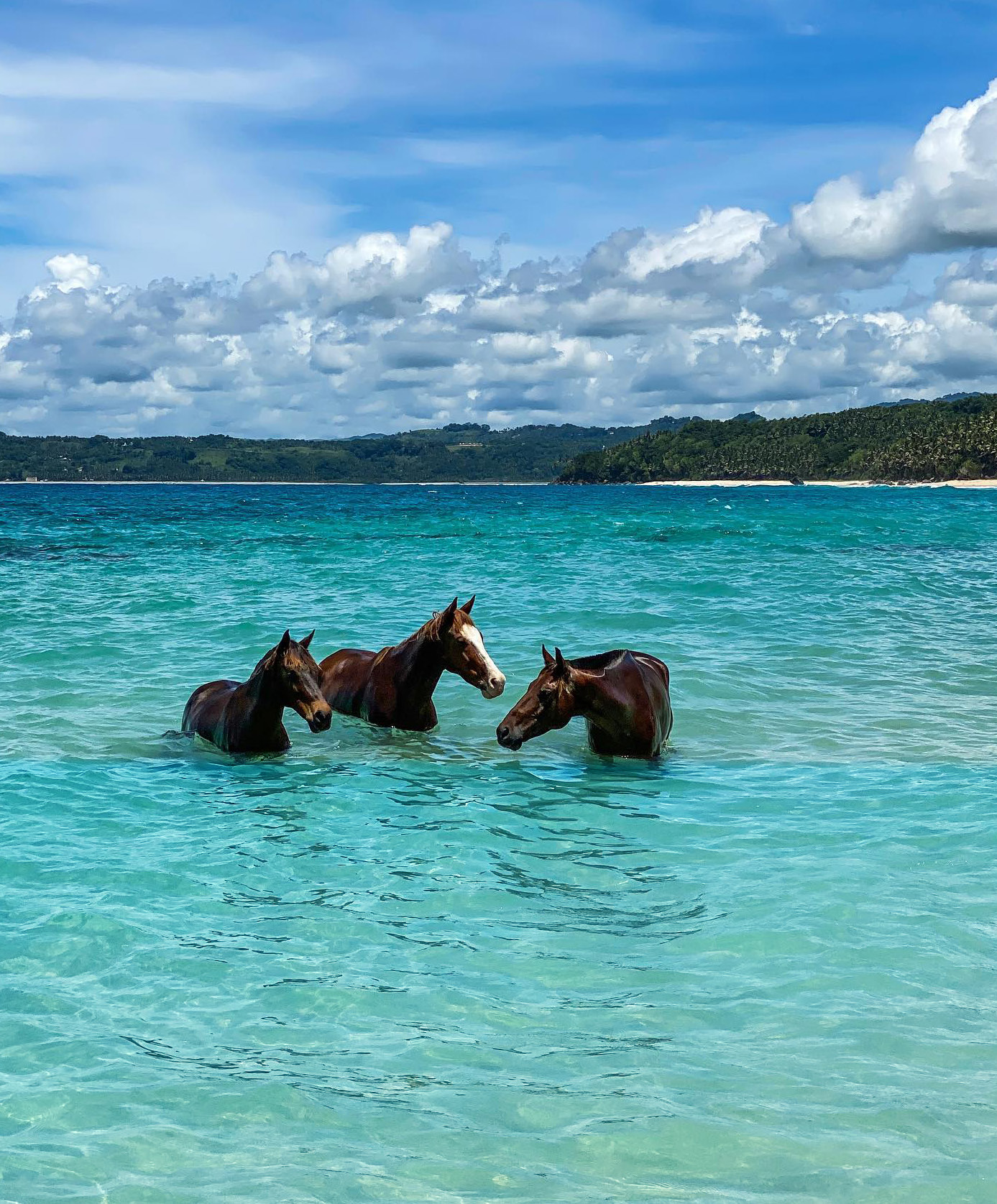Built to share the breathtaking beauty of an Indonesian island an hour from Bali, NIHI Sumba has been rated the best hotel in the world by Travel+Leisure. Sweeping views of the Indian Ocean surround the villas; handmade chocolates top the crisp white linens on the pillows and a wave-side, feet-in-the sand restaurant serves up a relaxed, private dining experience.
NIHI’s Sandalwood Stables offers rides to the beach at sunset or sunrise, as well as outings through the local villages and other day trips to the surrounding area. But most notably, the horses can be fitted with bareback pads and led down to the water, where you can sit on them as they wade, splash, and play in the water. Nothing compares to the amazing feeling as the horse beneath you leaves the ground to float briefly before stepping back onto the sand.
We spoke with Carol Sharpe, known as the horse whisperer of NIHI as a result of her work retraining the island’s racehorses for the hotel’s beach and trail rides.

Your Initial Assignment from NIHI was to source horses for beach rides. What made you consider ex-racehorses?
It basically came down to size. Most of the horses on Sumba are not suitable to carry an average-size Westerner; their origins are from Mongolian and Arabian ponies traded for Sandalwood on the islands. When I learned of the popularity of racing on Sumba and that the local ponies were being crossbred with the Australian Thoroughbred to produce a bigger, faster racehorse, this provided an avenue to source horses locally. With the pickings quite limited, my criteria really narrowed to horses at least 140 cm in size, as young as possible with the least amount of racing experience, and generally in good health.
How long did it take you to train them for beach rides, and how did you go about doing this?
Most of the horses responded well to gain trust and communication through groundwork. Some would respond in a matter of hours, while for others, it could take days or even longer. It was up to me to work out their language of cooperation. It really helped to attend some Sumba horse races to see how they are handled, where their fear triggers were, and how they might perceive me.
The horses are mostly trained to race from the fear-flight response, and I did observe this at the Sumba horse races where, at the start line, the horses are often given some raps over the rump with a plastic bottle to build their adrenalin before the jockey is thrown aboard (bareback) to race. With the jockey clinging to their back in an elevated, competitive state it effectively evokes their prey-animal flight from a predator response.

As with most horses (and particularly Sumba racehorses), their greatest reward was to feel relief from fear. I learned to always give them a choice. In training, if I could feel them under fear response pressure, I’d give them a way out so they could find a safer space before momentum built and resistance would disengage the part of their brain that is curious and cooperative.
Introducing a saddle was a good object for them to feel on their back without a competitive vibe, training them to take a rider that had a different agenda than racing was a little more challenging, especially when asking for upward transitions. Lots of small circle work and direction changes to keep them thinking. I also had to resist pulling back on their mouths as they were accustomed to harsh bits for control; their mouths are very desensitized as a result, and they pulled back strongly. These horses have taught me that the greatest key is awareness of your own energy and focus. If you can’t hold a state of presence and calmness, get off and try again later!
We began taking guests for beach rides within a couple of months of opening, though most of our early guests were novices and being led at a walk, which was a great advantage for the horses to learn their new role. Today, we still advise beginners to be guided under lead; however, we now have an incredible herd that can cater to an intermediate-level rider wanting to enjoy a relaxed canter down the beach. I am very proud of every single one of them and, of course, our incredible staff that is from the local villages.
The horses are used for beach rides and also for other excursions. Can you tell us a bit about these?
I believe NIHI has some of the most beautiful riding trails in the world. You’ll venture through virgin rainforest-covered mountains, cross valley streams and rivers, and pass through coconut groves and fields of rice that resemble a great patchwork quilt. Winding through the traditional villages, you’re greeted along the way with friendly smiles, and the only traffic jams you’ll encounter here is a herd or two of buffalo or goats being guided home by an attentive herdsman.
The horses are also popular stars in wedding ceremonies. Wedding photos are made uniquely Sumba memorable, with bride and groom being ushered to the alter by a horse and horseman donned in colorful traditional Sumba dress.
We are also working on having the horses play a major role in NIHI’s expanding wellness program. The classes I currently offer under my Equine Connection Experiences teach energy and self-awareness through learning equine communication. Guests have the opportunity to try yoga with, and on, a horse, as well as meditation practice with horses.

Once a year, these horses also become polo ponies. How do they react to this, and how do you manage the training?
It’s definitely interesting. Especially when I was asked to host the first British Polo Day (BPD) just 18 months from the start. I still hadn’t acquired enough larger crossbreds. It was a relief to learn that the BPD team was not expecting serious polo ponies and that they are always up to play polo on the out-of-the-ordinary—camels, elephants, pushbikes, and now rough and slightly wild Sumba race ponies.
Our training focus remained on calming for guest rides, but we introduced mallets and balls into the desensitizing training. We could only supply six horses for the game, so three aside, on about a quarter-size beach field using a larger arena ball. The game is not fast, as it’s being played in the sand. It can be hot, and hard going for the horses, so we play with shortened chukkers, and one final. The breaks between are gauged on the recovery of the horses, and this is usually taken with a dip in the ocean, saddle and all.
It’s a whole lot of fun trying to get control of the ball in the sand and watch pro polo players try to manage unruly Sumba ponies against my local horsemen that do it so much better. We still have spectators’ participation between chukkers to rake the pitch rather than stomping the divots.

Lastly, how easy is it to retrain a horse for a different job in life?
I heard a quote, I think from a dog trainer: “There are no untrainable dogs, just ignorant owners,” and I think this is true for just about everything in life, including training or retraining horses. If you ground yourself to your beliefs, you will more than likely get what you focus upon.
If you are interested in booking an adventure in Sumba, check out NIHI Sumba.

